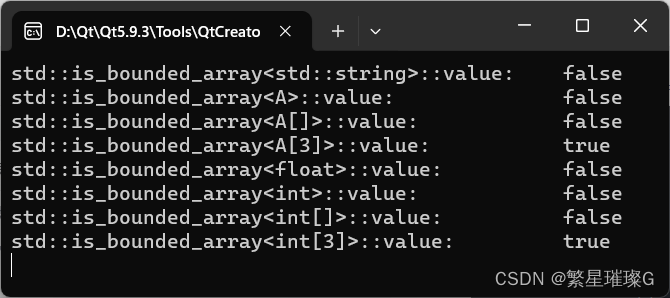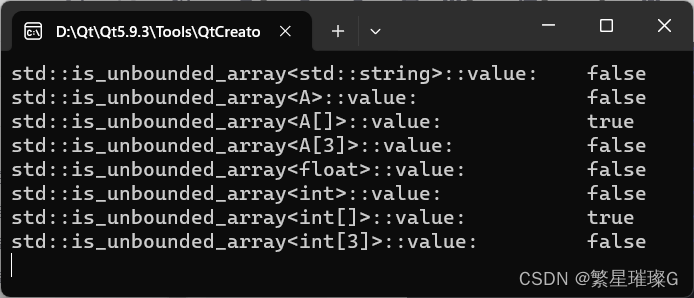本文主要是介绍C++标准模板(STL)- 类型支持 (类型属性,is_bounded_array,is_unbounded_array),希望对大家解决编程问题提供一定的参考价值,需要的开发者们随着小编来一起学习吧!
类型特性
类型特性定义一个编译时基于模板的结构,以查询或修改类型的属性。
试图特化定义于 <type_traits> 头文件的模板导致未定义行为,除了 std::common_type 可依照其所描述特化。
定义于<type_traits>头文件的模板可以用不完整类型实例化,除非另外有指定,尽管通常禁止以不完整类型实例化标准库模板。
类型属性
继承自 std::integral_constant
成员常量
| value [静态] | 若 T 为拥有已知边界的数组类型则为 true ,否则为 false(公开静态成员常量) |
成员函数
| operator bool | 转换对象为 bool ,返回 value(公开成员函数) |
| operator() (C++14) | 返回 value(公开成员函数) |
成员类型
| 类型 | 定义 |
value_type | bool |
type | std::integral_constant<bool, value> |
检查类型是否为有已知边界的数组类型
std::is_bounded_array| template< class T > | (C++20 起) |
检查 T 是否为拥有已知边界的数组类型。若 T 是有已知边界的数组则提供等于 true 的成员常量 value 。否则 value 等于 false 。
模板形参
| T | - | 要检查的类型 |
辅助变量模板
| template< class T > | (C++20 起) |
可能的实现
template<class T>
struct is_bounded_array: std::false_type {};template<class T, std::size_t N>
struct is_bounded_array<T[N]> : std::true_type {};调用示例
#include <iostream>
#include <type_traits>namespace std
{
template<class T>
struct is_bounded_array: std::false_type {};template<class T, std::size_t N>
struct is_bounded_array<T[N]> : std::true_type {};
}class A {};int main()
{std::cout << std::boolalpha;std::cout << "std::is_bounded_array<std::string>::value: "<< std::is_bounded_array<std::string>::value << std::endl;std::cout << "std::is_bounded_array<A>::value: "<< std::is_bounded_array<A>::value << std::endl;std::cout << "std::is_bounded_array<A[]>::value: "<< std::is_bounded_array<A[]>::value << std::endl;std::cout << "std::is_bounded_array<A[3]>::value: "<< std::is_bounded_array<A[3]>::value << std::endl;std::cout << "std::is_bounded_array<float>::value: "<< std::is_bounded_array<float>::value << std::endl;std::cout << "std::is_bounded_array<int>::value: "<< std::is_bounded_array<int>::value << std::endl;std::cout << "std::is_bounded_array<int[]>::value: "<< std::is_bounded_array<int[]>::value << std::endl;std::cout << "std::is_bounded_array<int[3]>::value: "<< std::is_bounded_array<int[3]>::value << std::endl;return 0;
}
输出

检查类型是否为有未知边界的数组类型
std::is_unbounded_array| template< class T > | (C++20 起) |
检查 T 是否为未知边界数组类型。若 T 是有未知边界的数组类型则提供等于 true, 的成员常量 value 。否则 value 等于 false 。
模板形参
| T | - | 要检查的类型 |
辅助变量模板
| template< class T > | (C++20 起) |
可能的实现
template<class T>
struct is_unbounded_array: std::false_type {};template<class T>
struct is_unbounded_array<T[]> : std::true_type {};调用示例
#include <iostream>
#include <type_traits>namespace std
{
template<class T>
struct is_unbounded_array: std::false_type {};template<class T>
struct is_unbounded_array<T[]> : std::true_type {};
}class A {};int main()
{std::cout << std::boolalpha;std::cout << "std::is_unbounded_array<std::string>::value: "<< std::is_unbounded_array<std::string>::value << std::endl;std::cout << "std::is_unbounded_array<A>::value: "<< std::is_unbounded_array<A>::value << std::endl;std::cout << "std::is_unbounded_array<A[]>::value: "<< std::is_unbounded_array<A[]>::value << std::endl;std::cout << "std::is_unbounded_array<A[3]>::value: "<< std::is_unbounded_array<A[3]>::value << std::endl;std::cout << "std::is_unbounded_array<float>::value: "<< std::is_unbounded_array<float>::value << std::endl;std::cout << "std::is_unbounded_array<int>::value: "<< std::is_unbounded_array<int>::value << std::endl;std::cout << "std::is_unbounded_array<int[]>::value: "<< std::is_unbounded_array<int[]>::value << std::endl;std::cout << "std::is_unbounded_array<int[3]>::value: "<< std::is_unbounded_array<int[3]>::value << std::endl;return 0;
}输出

这篇关于C++标准模板(STL)- 类型支持 (类型属性,is_bounded_array,is_unbounded_array)的文章就介绍到这儿,希望我们推荐的文章对编程师们有所帮助!





